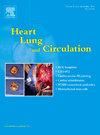记录土著人群的心血管-肾脏-代谢风险和疾病。
IF 2.2
4区 医学
Q2 CARDIAC & CARDIOVASCULAR SYSTEMS
引用次数: 0
摘要
目的:土著人和托雷斯海峡岛民承受着心血管、肾脏和代谢疾病的沉重负担,往往表现为多种疾病,造成了超过三分之一的预期寿命差异。本文通过记录早期风险负担、疾病和与疾病进展相关的因素,探讨了土著人群的心血管-肾脏代谢(CKM)健康。方法:对2008-2016年居住在澳大利亚中部的601名原住民进行前瞻性纵向队列研究。研究是由社区优先事项和伙伴关系推动并以其为基础的。基线数据包括问卷调查、临床评估和初级卫生保健数据;随访结果来源于初级保健临床回顾、行政住院和死亡率数据集。结果:4%的参与者(平均41.3岁,47%为女性)在基线时没有CKM危险因素(CKM综合征1期或以上),54.6%的参与者有心血管疾病、慢性肾脏疾病和/或糖尿病。CKM疾病和共/多病的存在与更大的社会经济劣势相关。在调整年龄后,合并/多重发病的参与者在随访期间死亡的可能性高于基线时无临床疾病的参与者(风险比[95%置信区间]:2.2[1.1-4.3])。在平均6.8年的随访期间,30.4%基线时无临床疾病的参与者出现了至少一种CKM症状,25%发展为合并/多重疾病。结论:该研究揭示了心血管、肾脏和代谢风险和疾病的患病率高于之前报道的,与非土著同行相比。卫生部门必须重新调整疾病预防,超越单一器官管理,并实施跨学科护理协调,以防止不公平现象扩大。本文章由计算机程序翻译,如有差异,请以英文原文为准。
Documenting Cardiovascular-Kidney-Metabolic Risk and Disease Within an Aboriginal Cohort
Aim
Aboriginal and Torres Strait Islander people experience high burden of cardiovascular, kidney and metabolic conditions, often manifesting in multimorbidity and contributing to over one third of life expectancy differentials. This article explores cardiovascular-kidney-metabolic (CKM) health within an Aboriginal cohort by documenting the burden of early risk, disease and factors associated with disease progression.
Methods
A prospective longitudinal cohort of 601 Aboriginal people living in Central Australia spanning 2008–2016 was utilised. Research was driven by and based on community priorities and partnerships. Baseline data included questionnaires, clinical assessments and primary health care data; follow-up outcomes were derived from primary care clinical review, administrative hospitalisation and mortality datasets.
Results
Four percent of participants (mean: 41.3 years; 47% female) had no CKM risk factors (Stage 1 CKM Syndrome or greater) at baseline, 54.6% had established cardiovascular disease, chronic kidney disease, and/or diabetes mellitus. Greater presence of CKM disease and co/multimorbidity was associated with greater socioeconomic disadvantage. After adjusting for age, participants with co/multimorbidity were more likely to die during follow-up (hazard ratio [95% confidence interval]: 2.2 [1.1–4.3]) than participants without clinical disease at baseline. During a mean follow-up period of 6.8 years, 30.4% of participants living with no clinical disease at baseline developed at least one CKM condition, and 25% progressed to co/multimorbidity.
Conclusions
This study reveals a higher prevalence of cardiovascular, kidney, and metabolic risk and disease than previously reported and compared to non-Indigenous counterparts. The health sector must recalibrate disease prevention, move beyond single-organ management and implement interdisciplinary care coordination to prevent expansion of inequities.
求助全文
通过发布文献求助,成功后即可免费获取论文全文。
去求助
来源期刊

Heart, Lung and Circulation
CARDIAC & CARDIOVASCULAR SYSTEMS-
CiteScore
4.50
自引率
3.80%
发文量
912
审稿时长
11.9 weeks
期刊介绍:
Heart, Lung and Circulation publishes articles integrating clinical and research activities in the fields of basic cardiovascular science, clinical cardiology and cardiac surgery, with a focus on emerging issues in cardiovascular disease. The journal promotes multidisciplinary dialogue between cardiologists, cardiothoracic surgeons, cardio-pulmonary physicians and cardiovascular scientists.
 求助内容:
求助内容: 应助结果提醒方式:
应助结果提醒方式:


